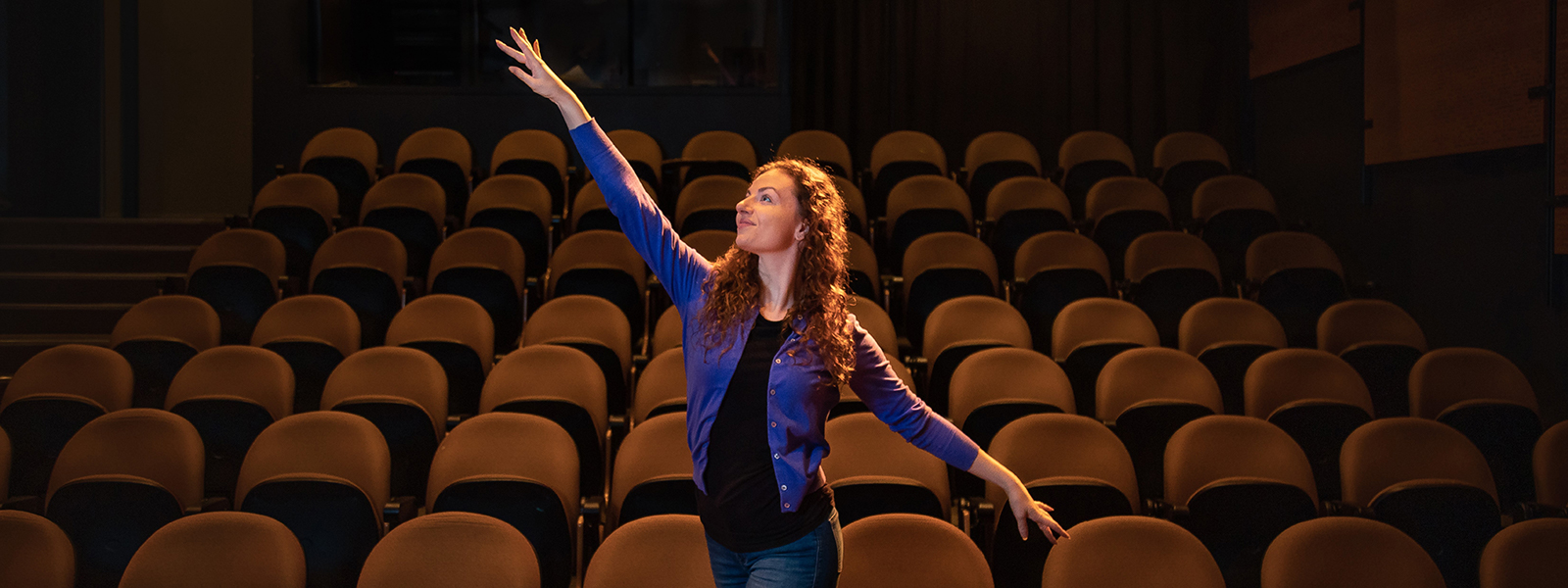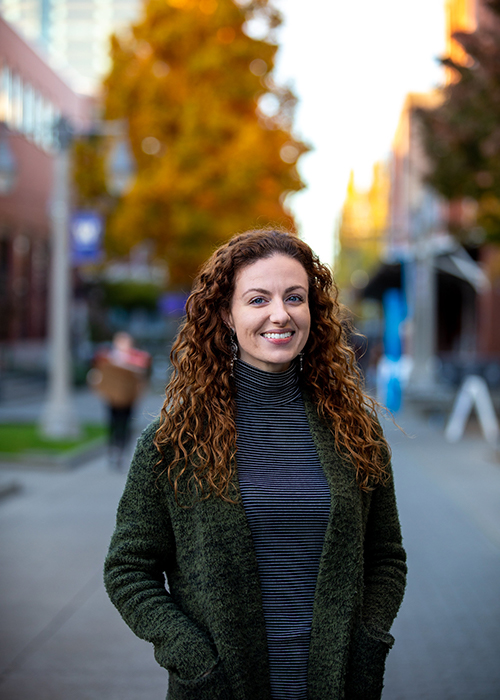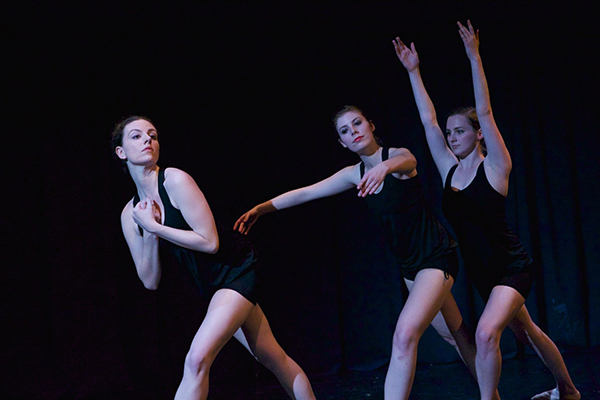
Dancing Scholar
UW Tacoma Assistant Professor Pamela Krayenbuhl brings her love and knowledge of dance to campus.
“What would YouTube be without dance?” says UW Tacoma Assistant Professor Pamela Krayenbuhl. A quick search of the site reveals the answer: not much. A seemingly endless number of results appear when one searches YouTube for videos of “dance” or “dancing.” Filtering the results by length and date posted helps—a little. Even then, you are still presented with an endless list that only seems to grow the longer you scroll.
All this is to say that dancing is popular — and not just on the internet. Turn on the TV and there’s “Dancing with the Stars”. Power up a game console and you’ll find “Fortnite” characters flossing or doing the Carlton. Movies are no different: think “La La Land” or “Footloose,” both the original and the 2011 remake.

In the middle of this whirling, twisting, happy choreography is Krayenbuhl. She’s something of a dancing scholar — pun intended. “My mom put me in ballet at the age of three,” she said. “I always kept it separate from my academic pursuits until I was about halfway through graduate school and was trying to figure out what my dissertation would be about.”
Krayenbuhl majored in rhetoric at the University of California, Berkeley. “Rhetoric at UC Berkeley was sort of the study of everyday argumentation,” she said. “It was part philosophy, part literary studies, part film studies.”
Krayenbuhl finished her bachelor’s at Berkeley, then enrolled in graduate school at Northwestern University. She planned to pursue an advanced degree in comparative literature. “Over time I became more interested in the history and politics of media objects,” said Krayenbhul. “I ended up with a doctorate in screen cultures.”
Screen-cultures is, as Krayenbuhl describes it, “a fancy way of referring to everything on screens.” Krayenbuhl specializes in dance on screen. “Folks in film and media studies don’t think about dance that often, so this seemed like a fresh, exciting thing that I both knew a lot about and could contribute to in a meaningful way,” she said. “I’m sort of a dance media historian.”
Technology, representation and appropriation
There’s a time not that long ago when a performance would disappear into the ether. A singer or dancer would walk off stage and the memory of what they did existed only in the minds of those who were there to see it.
Technology has changed how we experience the world. An amazing dance number can now be recorded and stored for years on sites like YouTube. “If you think about it, a lot of the dances that you’re probably most familiar with, you’re familiar with because you’ve seen them recorded in media,” said Krayenbuhl. “If it had been something that had just happened one time on stage and you weren’t there to see it, then you probably wouldn’t know about it.”
Dance routines can be complex, perfectly-timed sets of movements that take countless hours of practice to master. Similarly, the history of dance and its impact is just as multifaceted. “One of the big arguments that undergirds the book I’m working on is that what we consider to be dances of the United States are actually cobbled together from combinations of Indigenous dances, Asian dances and Africanist dances,” said Krayenbuhl.
How these dances are presented on screen and the meaning audiences take away are a big part of what Krayenbuhl researches. “Gene Kelly and Elvis Presley borrowed bits, pieces and sometimes an entire dance from lesser known black dancers,” said Krayenbul. “They [Kelly, Presley] were seen as sexy and virile but there’s sort of a double-edged sword because these same movements done by a black performer were viewed as dangerous or threatening.”
These issues of representation and cultural appropriation in dance are still very much alive. “Most of the dances in “Fortnite” are not “Fortnite” originals,” said Krayenbuhl. “A lot of them come from minoritized populations who’ve traditionally been oppressed by the societal structures that govern copyright and the accumulation of wealth.” Case in point, the default dance in “Fortnite” was first performed by “Scrubs” actor Donald Faison during the show. “He isn’t getting paid yet the company who made the game is making money,” said Krayenbuhl.
You wouldn’t think special-effects-laden blockbusters like “The Avengers,” from 2012, owe their success — at least partially — to the film musical genre, whose golden age extended from the 1930s to the late 1950s, but Krayenbul believes films like “Cover Girl,” a dance-heavy musical from 1944 starring Rita Hayworth and Gene Kelly, advanced what could be done in a movie. “Musicals needed the impossible to happen, the opposite kind of impossible. Instead of the scary or threatening kind of impossible, musicals need the fantastical, dream-like impossible where people are dancing on air or they’re dancing with cartoon animals.”
Telling stories in compelling ways
This is Krayenbuhl’s first quarter at UW Tacoma. For the past two years she served as assistant professor-in-residence at Northwestern University in Qatar. “It was a really wonderful experience,” she said. “Qatar is a great site for cultural exchange and an exciting place to teach film studies, especially because the vast majority of filmmakers in Qatar are women.”

Krayenbuhl teaches in the Culture, Arts & Communications Division of the School of Interdisciplinary Arts & Sciences. “This fall I’m teaching an introduction to film studies class and a science fiction class,” she said. “Next quarter I’m teaching a genre course on the Hollywood musical.”
Off campus, Krayenbuhl has already started taking ballet classes at the Pacific Northwest Ballet Company in Seattle. For the past 10 years Krayenbuhl has choreographed her own ballets. “They’re short and almost all of them are set to popular music like “Lana Del Ray” or “Hot Chip.” “I think ballet should be more accessible than it has historically been and can actually be really cool and fun.”
Krayenbuhl hopes to bring her love of dance to UW Tacoma. “I haven’t lived here long but I can already see that people here care about the arts,” she said. “The Tacoma community understands the power of allowing people to tell their stories in really compelling ways.”



